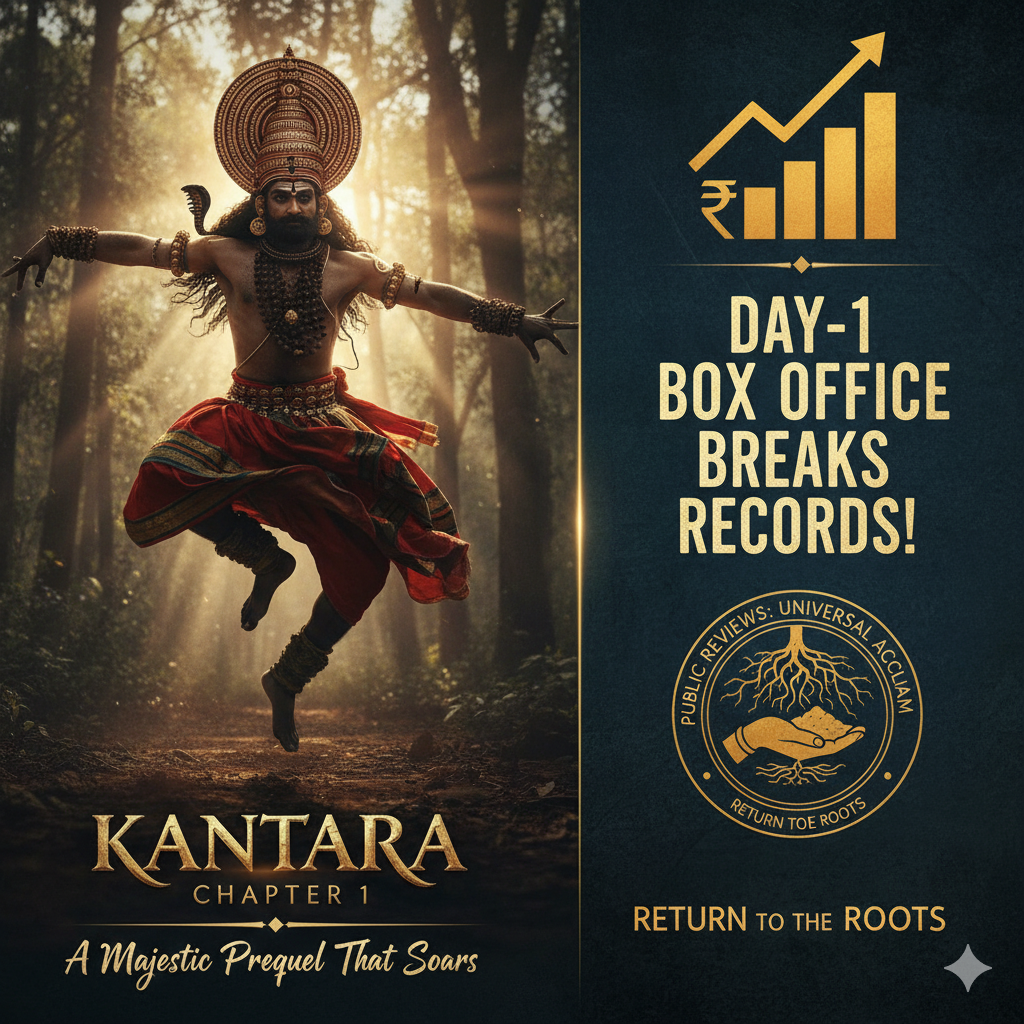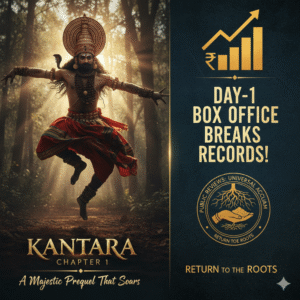Kantara Chapter 1: A Majestic Prequel That Soars — Public Reviews, Day-1 Box Office & Return to the Roots

The Kannada cinematic universe is celebrating a grand return as Kantara Chapter 1 hit theatres on 2 October 2025. A mythological period drama and prequel to the 2022 blockbuster Kantara, this ambitious film directed by and starring Rishab Shetty seeks to deepen the lore of Bhuta Kola, divine traditions, and the eternal dance between man and nature.
What is “Kantara Chapter 1”?
Kantara: A Legend – Chapter 1 is a 2025 Indian Kannada-language film that acts as a prequel to Kantara (2022). Set in ancient coastal Karnataka, it delves into the origin of rituals, ancestral conflicts, divine powers, and the folklore that shaped the first film’s world. Featuring Rishab Shetty as a mystical Naga Sadhu, the film also stars Rukmini Vasanth, Gulshan Devaiah, Kishore, and Jayaram among others.
With a runtime of 168 minutes, Kantara Chapter 1 was released in multiple formats (IMAX, 4DX, Dolby Cinema) and in several languages (Kannada, Hindi, Tamil, etc.). The scale and production values signal that this is not merely a spin-off but a cinematic elevation of the Kantara universe.

Public Reviews & Audience Feedback
Early Sentiment & Social Media Buzz
At the premiere shows, many audience members on social platforms praised the film as a “cinematic spectacle,” calling it immersive, visually grand, and spiritually resonant.
Some viewers expressed that the trailer’s tone—combining myth, action, and ritual—had already created massive expectations.
In fan forums and comment threads (e.g. on social platforms), opinions are mixed: while many hail it as a bold expansion of the Kantara mythos, a few skeptics raise concerns about narrative weight and pacing.
Critical & Media Reviews
Opinions from critics and media outlets have ranged from admiration for ambition to cautious criticism of execution:
Positive / Praising Notes:
Times of India highlights the “divine magic, epic action & unforgettable performances,” calling the second half “jaw-dropping.”
Koimoi describes the last 15-minute climax as a “benchmark for the decade,” elevating the film’s emotional punch.
GreatAndhra praises the film’s scale and visual grandeur, stating that although the narrative wobbles, it is redeemed by strong second-half moments.
Gulte notes that despite sluggish pacing early on, the performances of Rishab Shetty and Rukmini Vasanth anchor the film.
Kashvi Raj Singh (News18) gives 3.5/5, calling it a “visual treat” with a spectacular second half.
The Hindu remarks: “Despite flaws, ‘Kantara Chapter 1’ is a worthy prequel that rides on its gigantic scale and fine performances.”
Critical / Mixed Observations:
Some critics call the film “uneven,” noting the first half feels slow, the narrative occasionally drifts, and certain scenes (especially comedic inserts) feel out of place.
The Indian Express review suggests that while the original Kantara had a soul, the prequel sometimes loses that emotional clarity amid spectacle.
Rediff points out that Chapter 1 has “funny stretches in plenty” and tries to anchor its grand canvas with more levity than its predecessor.
Some negative feedback revolves around the view that the film is overhyped: aesthetic excellence notwithstanding, critics argue the core story lacks depth in moments.
Overall, the consensus leans toward appreciation of vision and performances, tempered by critiques of pacing and narrative consistency. The film seems to resonate most strongly in its second half and climax, which for many delivers the emotional payoff.
Day 1 Box Office Collections
One of the biggest talking points for Kantara Chapter 1 is its opening day performance, which has been widely reported across media outlets. Since different sources give varying numbers, here’s a balanced compilation:
Times of India live update reported a net India collection of ₹37.24 crore by evening shows on Day 1.
Early estimates and media reports also place the gross Day 1 collection at ₹60 crore (across all languages).
According to Koimoi, the film’s pre-sales (advance bookings) alone crossed ₹19.44 crore, marking one of the best pre-sales of 2025.
Koimoi also reports ticket sales of ~700,000 in the first 12 hours, with the Kannada version’s opening-day occupancy reaching 73.5% in morning shows and over 96% in afternoon shows.
For the Hindi dubbed version, early trends suggest a Day 1 range of ₹19–21 crore.
Some media also claim that by the end of Day 1, Kantara Chapter 1 grossed between ₹85–90 crore worldwide, with ₹72 crore domestically and ₹20 crore from the Hindi market.
While these figures vary, it’s clear that the film has opened with massive strength, trending among the biggest openings in Indian cinema in 2025.
Revisiting Old Kantara (2022): Legacy & Impact
To understand why Kantara Chapter 1 carried such expectations, one must revisit the original Kantara, which became a cultural phenomenon far beyond Kannada cinema.
Kantara was made on a modest budget (around ₹16 crore) but went on to earn an impressive ~₹309.64 crore (net India) across languages.
Its Day 1 performance in India was much smaller in comparison: approximately ₹1.27 crore net.
The film’s growth was powered by word-of-mouth, folklore-based themes, and its rooted portrayal of ritual — all contributing to its rise as a pan-India success.
Audiences appreciated the minimalistic yet powerful storytelling, the raw connection to land rights, nature, and the Bhuta Kola traditions, and the balance between spirituality and conflict. Many fans still describe Kantara as an emotional, soul-stirring cinematic experience.
On user review platforms (e.g. IMDb), some viewers called Kantara “hyped to the moon” but acknowledged its heart and beauty in execution. Because the original Kantara forged a strong fanbase and mythic resonance, Chapter 1 had both the burden and the privilege of expanding that world.
Why Kantara Chapter 1 Matters (and What to Watch For)
As a prequel, it has the challenge of honoring established lore while offering fresh stakes and surprises. Some reviewers feel that while Chapter 1 succeeds in scale, its narrative sometimes struggles to match its ambition.
The film’s climax and second half seem to be its strongest offering, delivering the emotional heft many had hoped for.
Technical aspects — cinematography (by Arvind S. Kashyap), visual effects, action choreography, production design, sound — are widely praised as big leaps over the original.
In a Pan-India context, the Hindi version’s performance and audience reception will be critical indicators of whether Kantara Chapter 1 can replicate or surpass the original’s cross-language success.
Some risk areas: narrative pacing (especially first half), integrating multiple languages and versions’ consistency, and ensuring that the mythos built doesn’t overburden the storyline.
Conclusion
Kantara Chapter 1 strides into theatres with ambition, expectation, and a legacy to uphold. Early public reception leans positive, especially for its visuals, performances, and emotional climax — even as critics note pacing and narrative dips. Its Day 1 collections, though reported with variation, clearly mark it as a major success and one of the biggest openings of 2025.
For fans of the original Kantara, this chapter offers deeper roots and more spectacle. For newcomers, it presents a mythic world rich in folklore, action, and cinematic ambition. Only time will tell whether Kantara Chapter 1 lives up to its promise across a full theatrical run — but for now, it has already made a bold statement.






